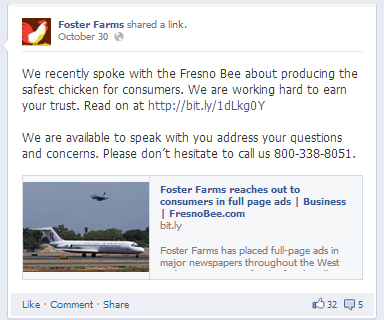This guest blog post was written by Linda Rastelli, a New Jersey-based journalist, video scriptwriter, publicist, ghostwriter, editor and author.
* * *
By Linda Rastelli
Months after salmonella-contaminated chicken distributed by a California company sickened people, the dangerous food is still being sold around the country.
Reading that in a New York Times editorial scared me.
I wondered whether I’m at risk because I buy chicken at Costco, which announced a recall of 40,000 pounds of chicken from Foster Farms that harbored “Salmonella Heidelberg.” Kroger Co. also took it off the shelves, while California-based Foster Farms continued distributing it.
Foster’s strategy not to recall the chicken in question is a high-stakes gamble.
Consumers are left confused, unsure whom to trust. I was reminded of another salmonella scare that caused me to eschew spinach for a time, despite knowing that was not entirely rational.
Emotions can trump facts. If people are frightened, the truth is irrelevant; your brand is damaged. Fear cripples, and may even kill, your reputation.
What can a Publicity Hound do to manage fear?
1. Apologize.
You may say, “What if I’m not at fault? Apologizing makes me look guilty when I’m not!”
Maybe you’re not guilty, but you defuse anger by saying you’re sorry people were hurt. Now, this isn’t legal advice; that’s not my purview. But even doctors who apologize for bad outcomes are sued less frequently for malpractice. Consumers want to feel that you care and won’t put profits above safety.
Foster Farms has apologized for people being hurt, but at the same time firmly maintained that its chicken is safe if well cooked, its official position.
2. Reassure.
If you suspect any issues about your product or service that may turn people off, deal with them, whether or not you think they’re legitimate. Maybe your industry has a bad reputation that’s rubbing off on you.
Don’t dismiss this. Get in front of it. Explain on your website and social media why yours is unlike the others.
The faster you respond during a crisis, the better. The longer you delay, the more unconcerned you may appear to the public. Your response should include what you are doing going forward, and a clear explanation of what happened and why.
Most important is your assurance that it will never be repeated. What steps are you taking? Although Foster says its chicken is safe, it also details its new procedures designed to exceed federal safety standards, above U.S. Department of Agriculture requirements.
Of course, even the best PR cannot save a bad product. If you try to conceal a health risk, eventually biology catches up with you.
Consumer Reports, among others, have publicly chided Foster Farms for not issuing a recall. If people continue to get sick, its strategy will look self-serving at best and duplicitous at worst. If things improve, the company will look vindicated.
3. Educate.
This is a good public relations opportunity for advocacy groups and Congress, as well as the poultry industry, to discuss food safety practices and to educate the public on their respective roles in protecting public health.
The Times blames “weak regulatory powers” at the USDA, and calls for Congressional hearings to tighten regulations. The public could use a debate. If people are losing confidence in the USDA’s standards, that’s a PR problem too. Foster itself implies the standards are too low by pledging to do more.
Consumers need explanations, instructions and information. Foster Farms devoted prime space on its Facebook page and website to answering questions.
So Who’s Sal Monella?
I remember Sal Monella. He was the Cubs shortstop back in the 70s.
* * *
 New Jersey-based Linda G. Rastelli is an award-winning journalist, video scriptwriter, publicist, ghostwriter, editor and co-author of Marketing: Essential techniques and strategies geared toward results (John Wiley & Sons, 2007) Connect with her on Google + and LinkedIn.
New Jersey-based Linda G. Rastelli is an award-winning journalist, video scriptwriter, publicist, ghostwriter, editor and co-author of Marketing: Essential techniques and strategies geared toward results (John Wiley & Sons, 2007) Connect with her on Google + and LinkedIn.






